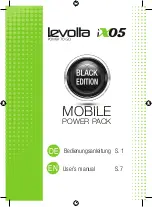
LDP200-200
2
USER INSTRUCTIONS
1) DESCRIPTION
DIN rail mountable primary switched-mode power supply with 170
–
528 VAC input, suitable for single or two phase mains line.
2) INSTALLATION
Use DIN-rails according to EN60715. Installation should be made vertically (see Fig.4). For better device stability fix the rail to the wall close to the point where the device
is to be mounted. In order to guarantee sufficient convection, we recommend observing a minimum distance to other modules
(see Fig.3).
Be sure to check that the mounting DIN rail is properly connected to earth (PE) before mounting the device
WARNING: Do not insert/ remove any wire if the device is not fixed to the DIN rail.
The device is provided with a thermal protection; a limited air flow can cause the thermal protection tripping.
The SMPS automatically restarts after cooling. To get normal operation reduce the temperature of the air surrounding the power supply, increase the ventilation or reduce
the load (see Fig.8)
3) CONNECTIONS
The device is equipped with pluggable screw terminals. To avoid sparks, do not connect or disconnect the connectors before having previously turned-off input power
and waited for internal capacitors discharge (minimum 1 minute)
In order to comply with UL certification, use appropriate copper cables of indicated cross section, designed for an operating temperatures of:
60°C for ambient up to 45°C
75°C for ambient up to 60°C
90°C for ambient up to 70°C
Strip the connecting ends of the wires according to the indication and ensure that all strands of a stranded wire enter the terminal connection (see Fig.5)
4) INPUT PROTECTION
The device input is provided with varistors against overvoltage. The input is not provided with internal fuses, thus an external short circuit/overcurrent protection must be
provided by the end user (see Fig.6).
For operation on a single phase or two phase system, a protection fuse on each phase must be provided.
Surge protection:
it is strongly recommended to provide external surge arresters (SPD) according to local regulations.
5) AC INPUT CONNECTION
The device can be connected to single phase AC line with Vin 230 VAC and two phase line with Vin 200
–
500 VAC (see Fig.7). Please connect the PE first.
6) DC INPUT CONNECTION
Connect L1 terminal to (+) positive pole, N terminal to (-) negative pole and
terminal to GND. Rated voltage 250
–
725 VDC.
The device is also suitable for photovoltaic or wind turbine applications (see Fig.7).
7) ENABLE INPUT CONNECTION
The device can be connected to AC lines or DC lines to provide an enable signal. With DC lines please be sure to respect the polarity.
Rated voltage 12
–
230 VAC / VDC.
The ENABLE line should be provided with a fuse type T, rated 250 V / 100 mA.
The ENABLE signal allows the output voltage to be switched ON or OFF. The ENABLE signal operating modes can be configured in the configuration menu. When the
ENABLE function is not active the output is continuously ON. The ENABLE signal can also be used to change (normally a reduction) the output voltage after a defined time
(used for an “over excitation” of a brake solenoid). In the configuration menu a delay time and a second voltage must be conf
igured to use this function.
8) OUTPUT CONNECTION
The device is suitable for SELV and PELV circuitry (having Vout higher than 60 VDC is not a SELV source).
Vout can be adjusted through a dedicated menu
through the push buttons "SET" “
”, “
” (see Fig.8).
The voltage present at the unit output is shown on the display.
Check Vout before connecting the power supply to the load! With output voltage > 80 VDC, the continuous current must not exceed the nominal power (187 W).
9) OUTPUT PROTECTION
The device is protected against overload (OL) / short circuit / Input Undervoltage (---) / overtemperature (OT).
Protection codes are shown on the display when the protection condition is triggered.
•
(OL) Overload protection:
if the output power (Vout*Iout) is greater that the nominal output power (187 W) for more than 3sec the output is
witched off and “OL” is shown on the display.
•
(OT) Overtemperature protection:
turns off the device if the internal temperature exceeds a safe limit (see Fig.8).
•
(---) Undervoltage protection:
turns off the device if the input voltage is < 160 VAC. It automatically reset when the input voltage comes back
to nominal values. This code (“
---
“) on the display can also indicate an internal failure.
•
(OL & OT) protections: No auto-recovery, recovery by primary shutdown or retrigger of enable input.
Behaviour in overload conditions:
The output current is limited to 2.4 A and the output power is limited to 187 W (constant current / power limitation). If the OL persists
for > 3 s, the unit is turned OFF and the OL alarm is displayed.
Enable:
Remote ON/OFF input.
Enable = 0:
Every time an error is displayed the device turns OFF the output. To reset the error you should turn OFF the device and after 10 s turn it ON.
Enable = 1:
Every time an error is displayed the device turns OFF the output. To reset the error you should apply a voltage (12 - 230 VAC / VDC) between the Enable
connector. If after both procedures the same error is displayed check the unit and/or the external conditions.























